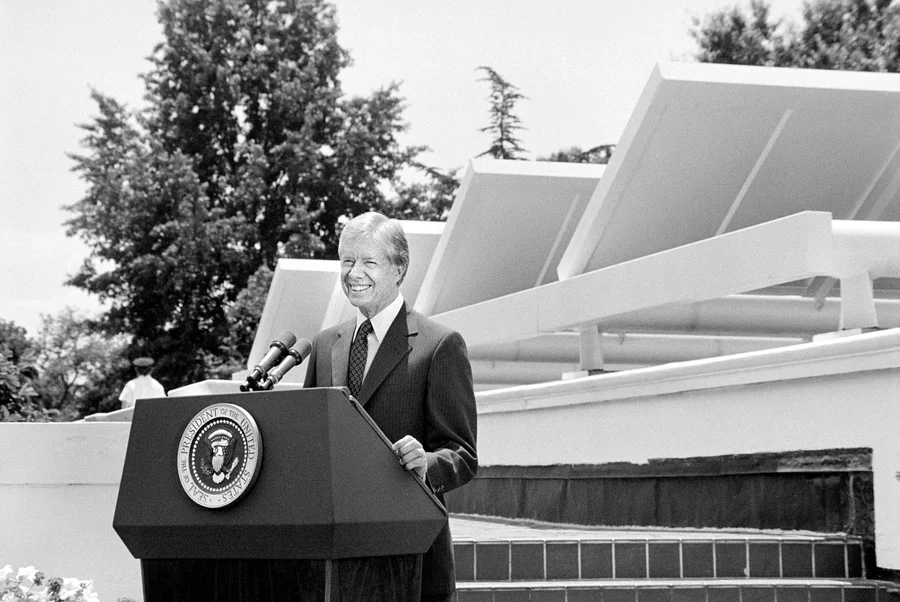
The intersection of politics and renewable energy has played a significant role in shaping the trajectory of the solar industry in the United States. Over the years, various presidents have implemented policies, initiatives, and regulatory frameworks that have influenced the growth and development of solar energy. In this blog post, we will explore the actions and contributions of U.S. presidents towards advancing the solar industry, from early advocacy to recent initiatives, highlighting the key moments and policies that have propelled solar energy into the mainstream.
Jimmy Carter: Pioneering Solar Advocacy:
President Jimmy Carter is often credited as the first U.S. president to champion solar energy on a national scale. During his administration in the late 1970s, Carter installed solar panels on the White House roof, symbolizing his commitment to renewable energy and energy independence. Additionally, Carter signed the National Energy Act of 1978, which included provisions for tax credits and incentives to promote solar and other renewable energy technologies. Although Carter’s efforts faced challenges and setbacks, his early advocacy laid the groundwork for future advancements in solar energy policy.
Ronald Reagan: Mixed Signals and Setbacks:
The Reagan administration marked a more challenging period for the solar industry, with President Ronald Reagan’s policies focusing more on traditional energy sources and deregulation. In 1986, Reagan controversially removed the solar panels from the White House roof, signaling a shift away from renewable energy priorities. Despite this setback, some states continued to pursue solar energy initiatives, laying the groundwork for future growth.
George H.W. Bush to George W. Bush: Limited Progress:
The presidencies of George H.W. Bush and George W. Bush saw limited progress in terms of federal support for solar energy. While there were some initiatives and incentives for renewable energy during this time, including the creation of the Department of Energy’s Solar Energy Technologies Program, overall support for solar remained relatively modest compared to other energy sectors.
Barack Obama: Accelerating Solar Growth:
The election of President Barack Obama ushered in a new era of support for solar energy in the United States. Under the Obama administration, significant investments were made in renewable energy through initiatives such as the American Recovery and Reinvestment Act of 2009. This legislation provided funding for solar projects, research, and development, helping to spur innovation and drive down the cost of solar technology. Additionally, President Obama implemented the Solar America Initiative, aimed at accelerating the deployment of solar energy across the country. By the end of Obama’s presidency, solar capacity in the U.S. had grown significantly, with millions of homes and businesses adopting solar energy.
Donald Trump: Policy Shifts and Uncertainty:
The presidency of Donald Trump brought about significant shifts in energy policy and regulatory priorities. While Trump expressed support for traditional energy sources such as coal and oil, his administration’s approach to solar energy was more mixed. On one hand, tariffs were imposed on imported solar panels in an effort to protect domestic manufacturers. On the other hand, Trump’s policies were criticized for rolling back environmental regulations and withdrawing from international climate agreements, creating uncertainty for the renewable energy industry.
Joe Biden: A Renewed Focus on Solar Energy:
The election of President Joe Biden has brought renewed optimism and focus on solar energy and climate change. Biden has outlined ambitious plans to combat climate change and transition to a clean energy economy, with solar energy playing a central role. The Biden administration has proposed significant investments in renewable energy infrastructure, tax incentives for solar deployment, and initiatives to promote equitable access to solar energy. Additionally, Biden has pledged to rejoin the Paris Agreement and prioritize climate action at home and abroad, signaling a strong commitment to addressing the challenges of climate change through solar and other renewable energy sources.
Conclusion:
Throughout U.S. history, presidents have played a pivotal role in shaping the trajectory of the solar industry through policies, initiatives, and advocacy efforts. From early champions like Jimmy Carter to recent leaders like Joe Biden, each administration has left its mark on the evolution of solar energy in the United States. As we look ahead to the future, continued support and leadership from policymakers will be essential to realizing the full potential of solar energy and achieving a sustainable, clean energy future for generations to come.
